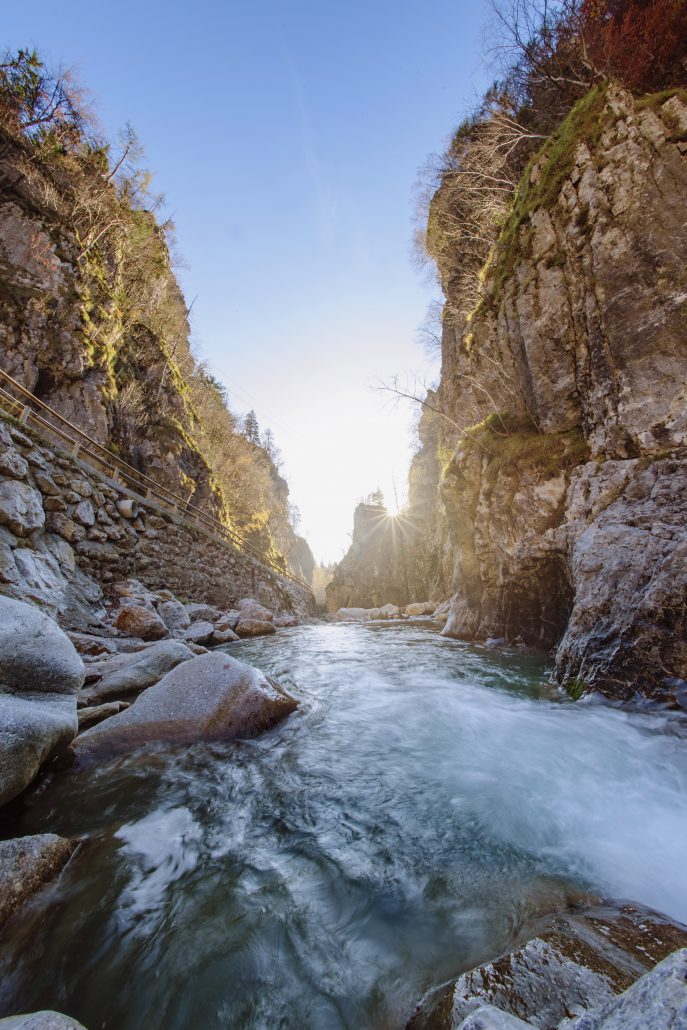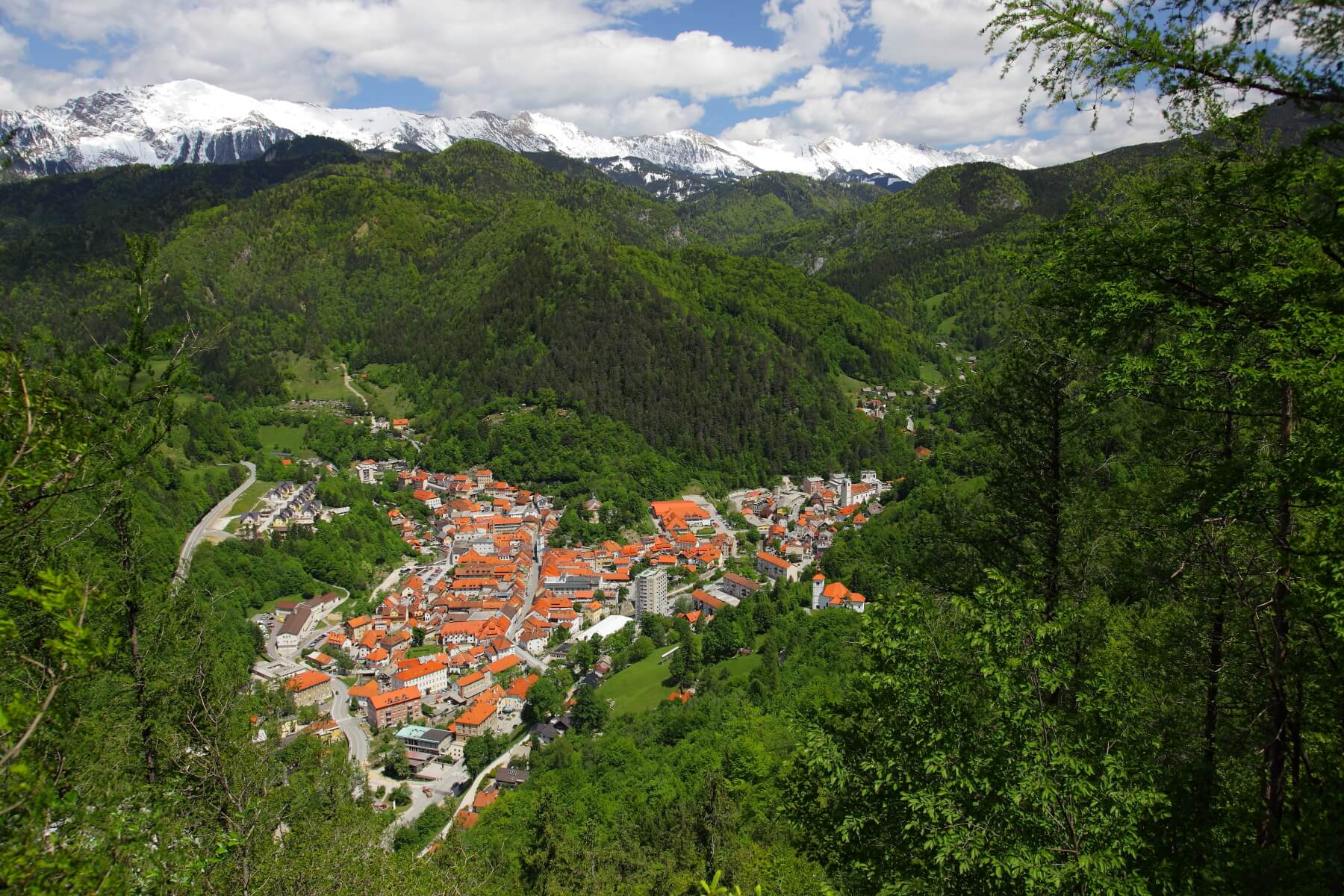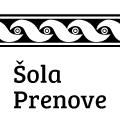From window to window, from portal to portal
Discover the stories hidden behind the windows of town houses. Flirt with not so typical portals. Find the rock that invites you to the nearby Dovžan Gorge!
Entry into the city
Take the circular path through Tržič at the mighty metal dragon which hatched from a rooster’s egg (1).
Enter into the old town across the stone bridge (2) with small pillars in which fossils from the famous Dovžanova soteska gorge are visible. At the first window, the patron saints of shoemakers wish you a pleasant wander. (3)
(From here to the next point: 2 minutes.)
A square of burgher houses
On Trg svobode square, stop at Mally’s House (4) with a beautiful Renaissance portal and stories from the times of tanners and dyers. Continue on to Dev House (5). Look at the typical Tržič wrought iron shutters and doors as well as at the drying holes on the roof. In Mestna kavarna café (6), treat yourself to the best desserts in town or taste the first Slovenian organic beer. Refreshed, continue to the house on the “upper corner” (7) and to Perk’s House (8) – the first house on the right bank of the Bistrica River, where there used to be fairs and the first inn in Tržič. At the end of the square is St. Andrew’s Church (9) and just opposite it is the last preserved prying window – “firbc vokn” (10), which is a local architectural feature. It made it possible to observe what was happening in the street without leaning out the window.
(From here to the next point: 4 minutes.)
Museum near water channel
Follow Koroška ulica street to the turn-off into Muzejska ulica street. In the old forging and artisan part of Tržič, next to the still preserved rake (water canals with barriers), is the building of the former Pollak Dyehouse and Tannery. Here, the Tržič Museum (11) presents former crafts. It is worth a visit.
(Recommended time for a stop: 60 minutes. From here to the next point: 6 minutes.)
A manor instead of a burnt down castle
After visiting the museum, return to Koroška ulica street. In Pod gradom pizzeria treat yourself to a dish from the brick oven, and then climb up to the Neuhaus Castle (12). The famous Marshal Radetzky built the building on a hill in the centre of the town after a fire that destroyed the original castle in 1811. From the castle garden a beautiful view of the streets of the town of old crafts spreads.
(From here to the next point: 8 minutes.)
Down to the authenticity of the 18th and 19th centuries
From the Neuhaus Castle, take the steps down to Partizanska ulica street. Observe opestniki (hubstones)- roadside stones, named after the hub (pesto) on the wheel cart. As the wheel hit the roadside stone, it did not damage the house.
To the left and across the bridge you reach Kurnik house (13). The most comprehensively preserved Tržič house, built in the 18th century, also survived a major fire. If you arrange a visit at the Tržič Museum, you can discover the heritage of cartwright making on the first floor, and try to bake Tržič flika – a typical local round cake – on the ground floor with the preserved original interior from the 19th century (14).
(Recommended time for a stop: 45 minutes. From here to the next point: 2 minutes.)
Return to the beginning of the story
Just a stone’s throw away from Kurnik house you can admire a moving wooden masterpiece all year round – a nativity scene with special wooden figures. The Tekec Nativity Scene (16) evokes a Christmas story any day of the year.
From here, you can return to the starting point along Cankarjeva ulica street- back to the Tržič dragon (1), with which your stories of an interesting medieval town with a rich heritage of crafts began.
A Tip: You can collect your impressions from the walk in Kavarna Platz Café, in the atrium of the Municipality of Tržič. The Tourist Information Centre, where you can get additional tips to explore the Tržič area, is in immediate vicinity.
Suggestions for a hike
To Dovžanova soteska gorge
Venture to the Dovžanova soteska gorge alone or with a guide. It is less than 4 kilometres from the centre of Tržič. The gorge, which was carved into the varied stack of rocks from the late Paleozoic by the mountain river Tržiška Bistrica, is considered an exceptional natural monument in the Karavanke. Here you can observe the most complete sequence of rocks from 260 to 300 million years old. Discover the fossils embedded in them on the scenic learning trail next to the rocks.
More information: Tržič TIC
www.visit-trzic.com

1. The dragon from the rooster's egg
Opposite the Tržič bus station, a sculpture of a dragon, made of more than a ton of iron or from as many as 200 meters of pipes and more than 900 meters of iron strips greets the visitors. The sculpture recalls the legend of the origin of the town of Tržič.
A giant dragon is said to have hatched from a rooster’s egg. With its might, it split apart the mountain of Košuta and at the same time triggered a rock avalanche that buried the settlement under the mountain. Residents escaped by running into the valley. Tržič is where they stopped.
nasproti stavbe Predilniška cesta 1
2. Stone bridge
The bridge over the Tržiška Bistrica is adorned with ten pillars of red Trogkofel limestone from the Dovžanska soteska gorge – an important geological area near Tržič. Remains of fossils are visible in the pillars.
Predilniška cesta – Trg svobode
3. Crispin and Crispinian windows
At the beginning of the main street in Tržič, on the facade of the Trg svobode 6 house, Crispin and Crispinian – the patron saints of shoemakers – draw attention to the town’s heritage. Tržič has long been famous for its “šuštars” (cobblers) and for Šuštarska nedelja (Cobblers Sunday) – a large September fair and entertainment event. The shoemakers worshiped Crispin and Crispinian, who were supposed to be born on Monday – the day when shoemakers did not like to come to work.
Trg svobode 6
4. Mally's house
The burgher-noble mansion bears the year 1618 on the Renaissance portal. It was then erected by the owner of the ironworks, Ignacij Jabornik. The last of the wealthy Jaborniks was known in the town for lighting his cigars with banknotes. His descendants became impoverished and had to sell the house to the Mallies – the tanners.
Trg svobode 5
5. Dev house
The birthplace of the founder of Slovene secular poetry, Janez Damascen Dev (1732 – 1786) and the author of the first Slovene libretto – the lyrics for the Belin opera, has two well-preserved Tržič special features. The wrought iron shutters and doors, which were commanded after the great fire of 1811, prevented a new fire to spread through the town. The drying holes on the roofs were used for drying hides, linen and socks in this town of tanners and artisans.
Trg svobode 25
6. Town Cafe
Get to know Tržič by tasting local dishes and drinks. In the Town Café in the renovated Brodar House, you can taste the first Slovenian organic beer, brewed at the Šlibar organic farm near Tržič. The café is famous for sweets such as Radetzky’s chestnut cake, Dragon’s cake and the Dovžan’s gorge cake.
Trg svobode 24, T: 041 552 380
7. The house on the upper corner
The house was owned by the Mally tanners, who married their daughters to the rich and influential men. Hilda Mally was betrothed to Professor Sušnik, who was even the Yugoslav Minister of Transport between the two world wars. Hilda was therefore fondly called the Tržič Lady Minister. In 1900, the first kindergarten in Tržič got its premises in this house on the upper corner.
Trg svobode 30
8. Perko's house
In the 12th century, the first person to build a house on the right bank of the Bistrica was the blacksmith Vincenc Klander. The locals soon began to refer to it as “semnovka”, probably because they held fairs there to sell their products. Later, the first town inn was located here.
Trg svobode 31
9. St. Andrew’s Church
St. Andrew’s Church stood at the upper end of the main square before 1526, when all the churches were documented due to the Turkish tax. The church was demolished in 1865 and the current one was built in its place. In the years 1871–1880, Jakob Aljaž was a chaplain here. He was an enthusiastic Slovene, a good singer and mountaineer. During his service in Tržič, he translated the most famous Christmas song “Stille Nacht, heilige Nacht” (Silent Night, Holy Night). It was in Tržič that this song was sung in Slovene for the first time.
križišče Trga svobode, Partizanske in Koroške ceste
10. Firbc vokn
The people of Tržič are proud of the special design of the window, which shows former ingenuity and curiosity. Through the outwardly protruded and glazed window at the bottom, curious Tržič ladies could observe what was happening in the street without having to open it or bend over it.
Koroška cesta 1
11. Tržič museum
The town museum is located in the interesting ambience of the former tannery and blue printing house. It presents the once extremely highly developed trades and crafts that were the livelihood for many Tržič residents. Listen to the songs and testimonies, detect the smell of leather, do a test with a cobbler’s lamp, put on unusual shoes from the old times, feel the yarn, and feed the dragon. Both the new exhibition of leather, shoemaking, socks, textiles, dyeing, and the Slovenian Ski Museum present the past in a fun, educational way.
Muzejska ulica 11, T: 04 53 15 500
12. Neuhaus castle
The most famous owner of the castle was Count Johann Josef Wenzel Radetzky von Radetz, an Austrian field marshal of Czech descent, who bought the castle together with the estate from his mother-in-law and occasionally lived there between 1807 and 1819. When Tržič was hit by a terrible fire in 1811, the fire did not spare even the old Neuhaus Castle. Count Radetzky had a new smaller mansion built a little lower than the original, and all the money he received as compensation for the burnt castle was left to the poor of Tržič.
Koroška cesta 24
Opestniki (hubstones)
On Partizanska Street you can see many stones along the side of the road, called opestniki, or “hubstones”. They are named after the hub of a wagon or cart wheel, which would hit the roadside stone and thus be prevented from damaging the houses and their facades.
Partizanska ulica
13. Kurnik house
The best overall preserved house in Tržič, built in the 18th century, survived the great fire of 1811. The ground floor is stone-built, the floor is wooden, and the roof with drying openings is covered with shingles. Upstairs, there are two wreath kitchens and a white one, and a typical gank (a balcony).
Over more than three centuries, the house has changed owners, design and function. Today, it is named after Vojteh Kurnik, the poet and cartwright, who was born here in 1826. By prior arrangement, you can also try to bake Tržič flika in this oldest house.
Kurnikova pot 2, T: 04 53 15 500 (Tržiški muzej)
14. Tržič flika
The Tržič flika is a locally popular round cake. Once, it was prepared from bread dough leftovers. When the housewives kneaded the dough, they tore off a part of it, rolled it out thinly, spread it with minced lard or sour cream and sprinkled with cumin.
Among the dishes from the Tržič area are also Tržič bržole – small pieces of mutton in a savoury stew.
15. Tekec nativity scene
The Tekec Nativity Scene is one of the most beautiful achievements of folk and religious culture in Slovenia. Between 1935 and 1970, Jožef Ribnikar, a shoemaker from Tržič, carved the original nativity scene from linden wood with a cobbler’s knife. Each wooden figure is unique in itself, and of particular interest are double or triple figures carved from a single piece of wood. In the manger, some figures are also moving: shepherds are walking, Mary is rocking, a shepherd is chopping wood, angels are circling over the stable, a shepherd is pumping water, and the bells are ringing.
Cerkvena ulica 2a, T: 051 274 374
- 11. The dragon from the rooster's egg
- 22. Stone bridge
- 33. Crispin and Crispinian windows
- 44. Mally's house
- 55. Dev house
- 66. Town Cafe
- 77. The house on the upper corner
- 88. Perko's house
- 99. St. Andrew’s Church
- 1010. Firbc vokn
- 1111. Tržič museum
- 1212. Neuhaus castle
- 13Opestniki (hubstones)
- 1413. Kurnik house
- 1514. Tržič flika
- 1615. Tekec nativity scene





